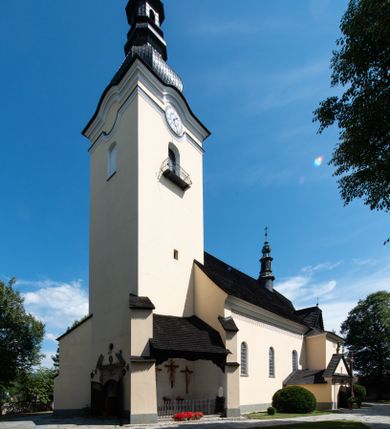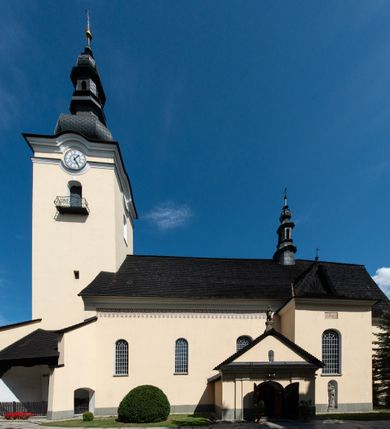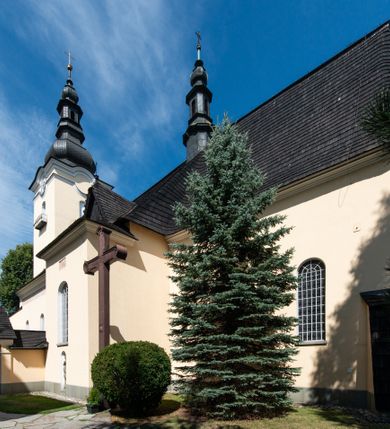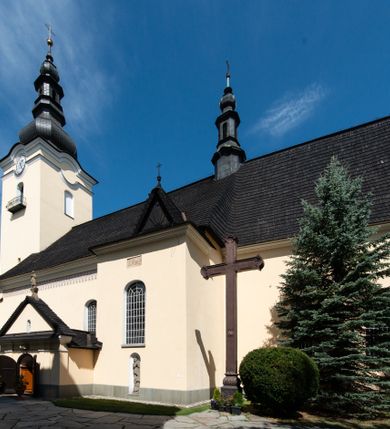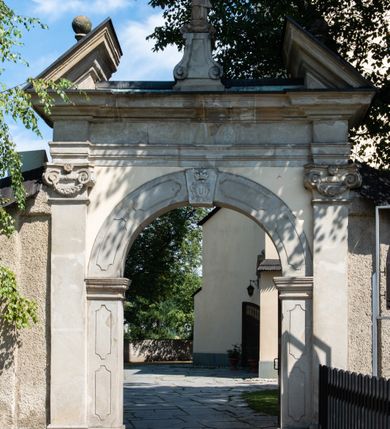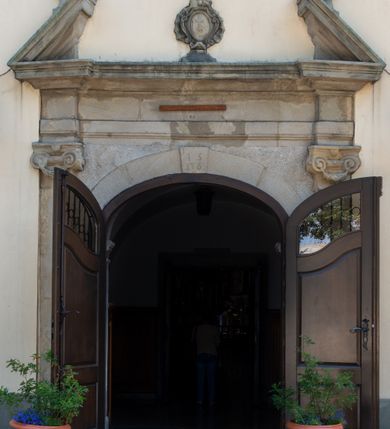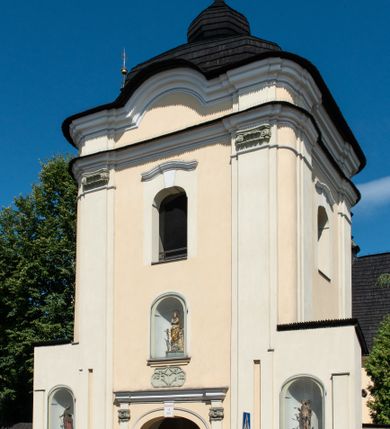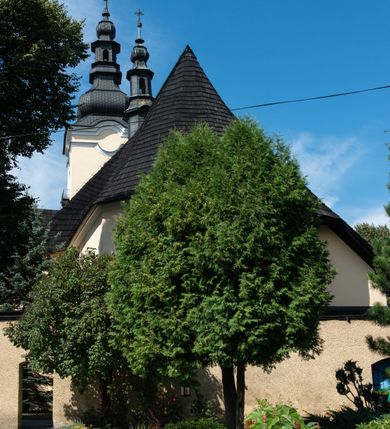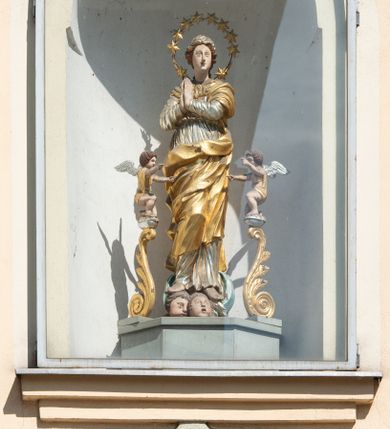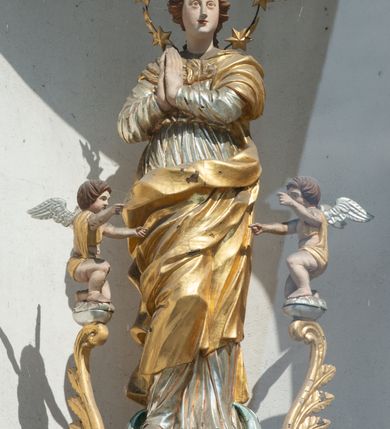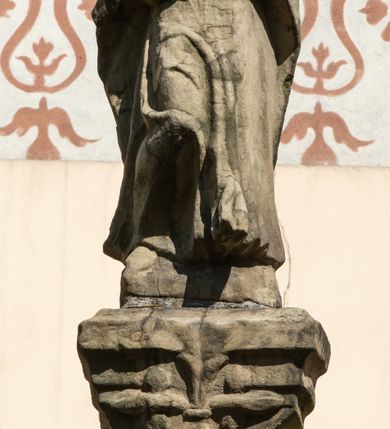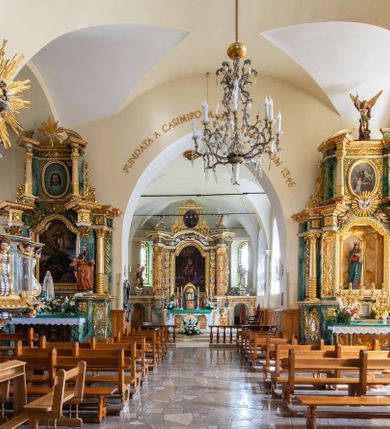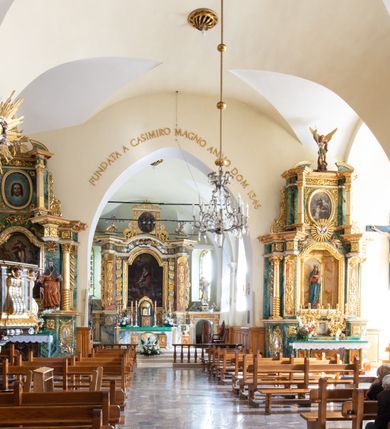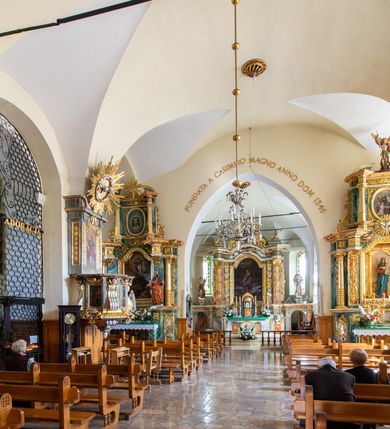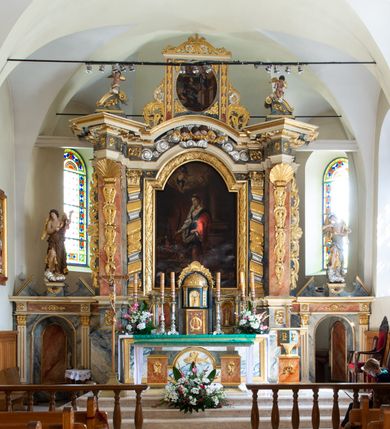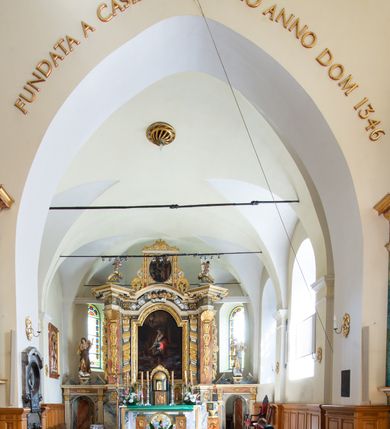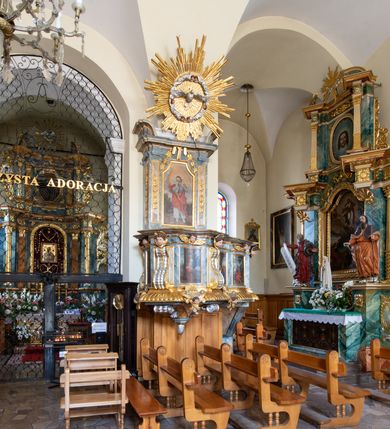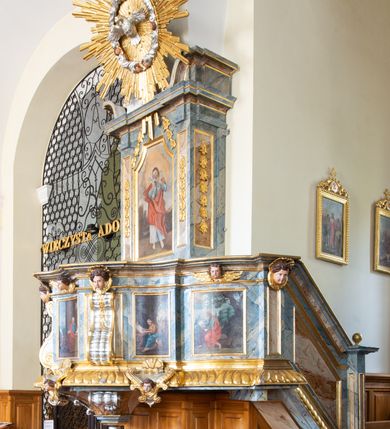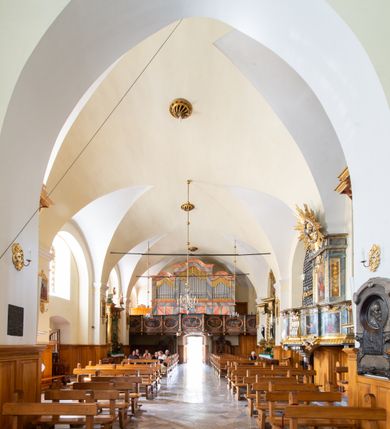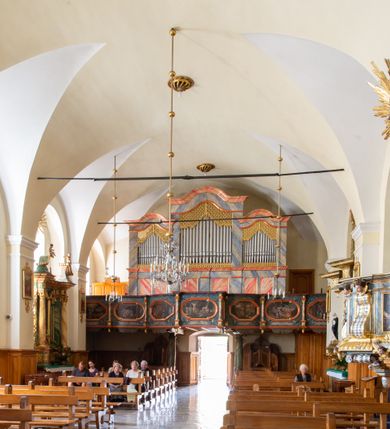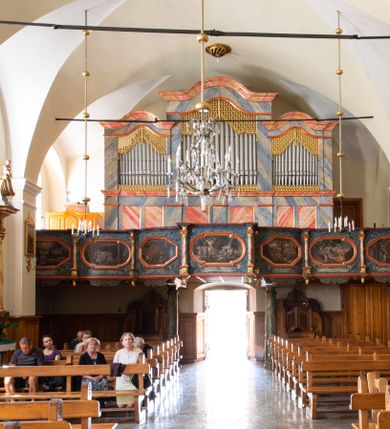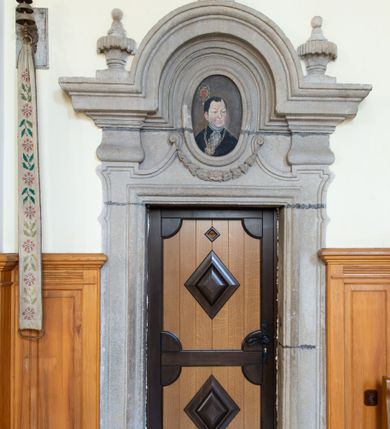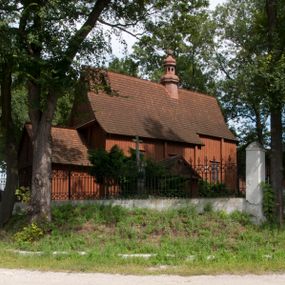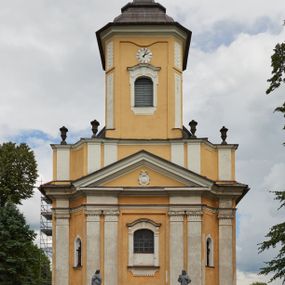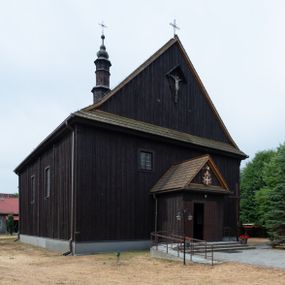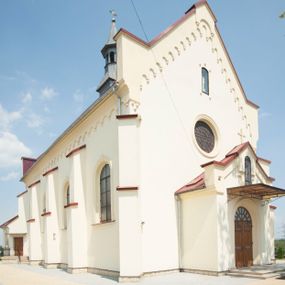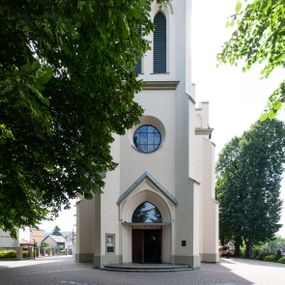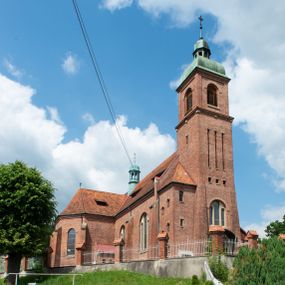
Church of St. Catherine of Alexandria in Nowy Targ
Identifier
DZIELO/22214
Amount
1
Catalogue note author
Maria Działo
History of work
The first church under invocation of St. Catherine of Alexandria in Nowy Targ was founded in 1327 (or 1326). The temple was noted in the files of the episcopal visit from 1596 with a description that the chancel was made of brick and the rest of the church was wooden. There were four altars, organs and a crucifix on a chancel opening beam. The church burned down on May 7, 1601 along with the entire city. It was just the brick chancel with the high altar and the sacristy that were not damaged by the fire. King Zygmunt III, upon hearing of this damage, released the inhabitants of Nowy Targ from all taxes and tributes for a period of four years. In the years 1606-1655 a new stone church was built, as evidenced by source documents, as well as an inscription found during the renovation in 1926 on the outer southern wall: "AEDIFICATA H(A)EC EC[C]LESIA / A[NNO] D[OMINI] / 1606 / PETRVS CZARNY MVLARS "(a fragment of the decorative frieze was also exposed at the western corner of this wall). On September 14, 1649, Bishop Wojciech Lipnicki consecrated the church. The rosary chapel deserves special attention. According to some researchers of the history of the church in Nowy Targ, it was built in 1634, according to others in 1717, according to the act of the foundation of priest Mikołaj Szczegliński, when it was granted its own organist, organ, cantor, bell tower, equipment and canonicals. The chapel was founded on January 13, 1771.
The church suffered again during the Swedish invasion in 1657. On October 16, 1668, Bishop Mikołaj Oborski consecrated the altars. Subsequent fires consumed the previous works - on November 15, 1710 and August 2, 1719. The church was restored after being burned before 1727, which was noted in the episcopal files of this year: "quod est totaliter murata post conflagrationem restaurata, Tituli S. Catharinae Virginis et Martyris, non consecrata ". These altars also mention of six altars: the main one: St. Catherine (freshly decorated) and side ones: of Transfiguration, St. Anna (Brotherhood of St. Anna), St. Jan Kante (new), St. Anthony of Padua, as well as the altar in a stone chapel - the Blessed Virgin Mary. In the years 1761-1765 seven altars were recorded in the temple, the main of which was decorated with a picture of St. Catherine, decorated with 193 pearls and silver dresses. In 1761, priest Tomasz Rechowicz, apostolic notary and royal secretary noted the poor condition of the church: "The whole church, although made of stone, has been damaged and scratched, the plaster has fallen off and the stones have fallen, there are 7 altars in a wooden church". Therefore, the church underwent a thorough modernization (1765-1784), while the parish priest was canon Józef Kazimierz Sawicki. A porch, a cemetery wall with a late baroque gate, a bell tower and portals were built then, the organ was expanded. The first of them, in the church gate, was decorated with the coat of arms of priest Sawicki (Nowina), his initials and the date of renewal - 1765. The portal at the second entrance was crowned with a sculpture of St. John Nepomucen, and above the entrance to the sacristy the renovator placed his portrait. A new portal was also built under the tower at the church gate and in the entrance to the sacristy. A clock tower was built, and a round tower with a steeple above the center of the church. The renovated temple was reconstructed by Bishop Franciszek Potkański on October 21, 1766. Another fire of 13 June 1784 destroyed the roof of the church, and also destroyed one of the wooden lofts. The opening that remained was bricked up and probably a window was located in this place, visibly different from the others. After the death of parish priest Sawicki (1789), father Szymon Zamoyski continued his work. The southern porch comes from this period with the sculpture of St. Tekli - a patron during fires and plague.
In the following centuries, the disaster of fires did not leave the temple in Nowy Targ. The next ones took place in 1804, 1819, 1839, 1872 and 1932. In 1819 or 1820, the church tower was erected, in which a document was hidden in a brass knob (discovered during restoration works in 2005). A thorough renovation was carried out in the 1890s. At that time, a reproduction of the existing, heavily damaged altar painting was made, along with the new stations of the Cross, sculptures to the altar of St. Anthony - St. Teresa and St. Cunegonde. As a result of the last conflagration, the roof of the church burned down, the organs and part of the side altars were destroyed. The damage was restored when father Franciszek Karabuła (1926-1945) was the parish priest. In 1928, the church was painted by Władysław Genga Jankowski-Nowotarski and Antoni Bełtowski. On March 19, 1932, the last fire in the temple broke out, which Father Mieczysław Łukaszczyk described in the church's history: "[...] at 2.00 a fire broke out in the church of St. Catherine. A boy saw fire - a Jew from a baker from School Street He woke up the police and the Parish Priest The bells rang for alarm. They woke up the city's inhabitants. Who hurried to the church to see what happened. [...] Jews also helped to put out the fire and carried water. Two altars were burning: the masonry and bakery one of St. Valentine and St. Rozalia. In the masonry altar there was a figure of the Mother of God with the Child and fire did not touch her. It did not touch also Jesus Crucified, hanging above the bakery altar. All the painting art was destroyed and the interior of the church was black. The entire organ was also destroyed. At the expense of the offerings of bricklayers and bakers and other faithful altars were reconstructed by the artist Franciszek Szumal "Groberek", a sculptor from Ostrowsk, a graduate of the Zakopane school of fine arts [...]." The church and altars were renovated after this fire. Another thorough renovation was carried out in 1990 (altars, pulpit and organ loft were renovated, new pews and confessionals were purchased). In 1996, the inscription "FUNDATA A CASIMIRO MAGNO ANNO DOM [INI] 1346" was placed above the arcade of the chancel opening.
Abstract
Church of Saint Catherine of Alexandria is a building with simple architectural forms, but with a complex record of the creation. The chancel was created in the first half of the 14th century, and the nave in 1601-1655, which, as evidenced by the inscription on the wall, was erected by Piotr Czarny, a bricklayer. The high altar was built in the first quarter of the 18th century, however it was significantly changed in the 19th century. In the main area of the altar there was originally a painting of Saint Catherine by Franciszek Lekszycki. It is currently occupied by a copy by Władysław Rossowski from 1892. Noteworthy is also the choir parapet from the first quarter of the 18th century, decorated with paintings modelled on engravings illustrating the work of the Flemish Jesuit Herman Hugo "Pia desideria emblematis elegiis et affectibus SS. Patrum illustrata", i.e. "Pious desires, explained with emblems, elegies and feelings of holy Fathers", issued in 1624 in Antwerp. In the chapel of the Virgin Mary, in turn, closed with an 18th-century lattice with a Marian monogram among lilies, there is an altar funded by prebendary priest Adam Gorczyński (1753-1760), and two paintings located in it: Our Lady of Perpetual Help in the main area of the altar and the Assumption of the Blessed Virgin Mary in the altar finial. On the eastern wall of the chapel, there is a painting of the Holy Family from 1516, moved to this place for security reasons from the cemetery church of Saint Anne in Nowy Targ (a copy by Marek Hapka is placed there). In the chapel there is also a baroque baptismal font, the core of which is an angel supporting the bowl like a caryatid. Inside the temple there are Stations of the Cross hanging, from 1894, painted by Stanisław Bryniarski.
Other works from this place
Similar works
By title
By category
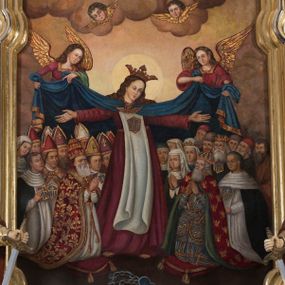
Our Lady of the Redemption of Slaves
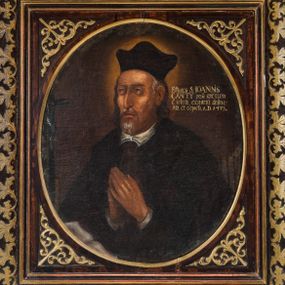
St. John Cantius
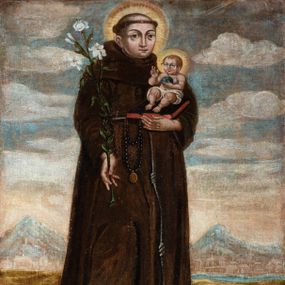
St. Anthony of Padua
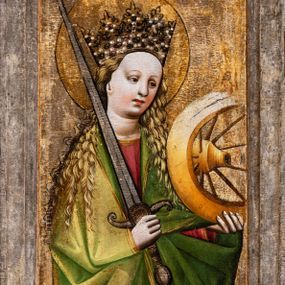
A front left wing of the old triptych of Our Lady of the Immaculate Conception
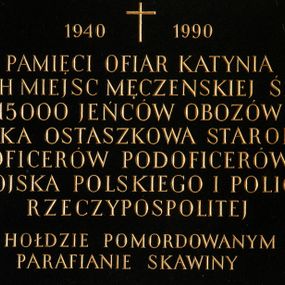
A plaque commemorating the victims of extermination
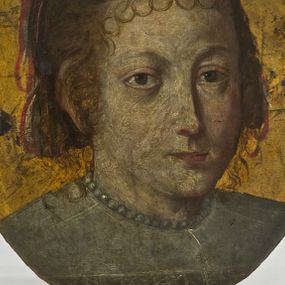
A portrait of Zofia Kochańska of the Swierczewski family
How to cite?
Maria Działo, "Church of St. Catherine of Alexandria in Nowy Targ", [in:] "The Sacred Lesser Poland Heritage", 2026, source: https://sdm.upjp2.edu.pl/en/works/church-of-st-catherine-of-alexandria-in-nowy-targ
